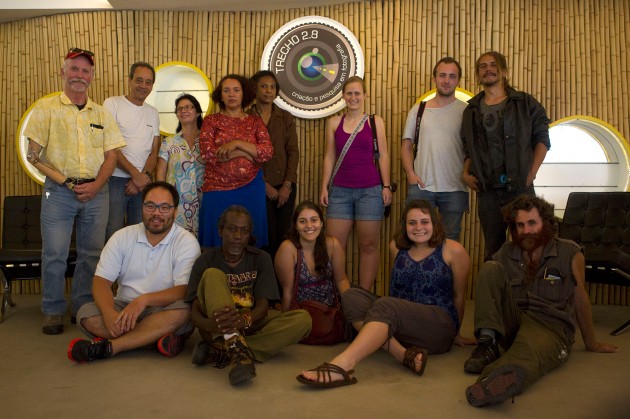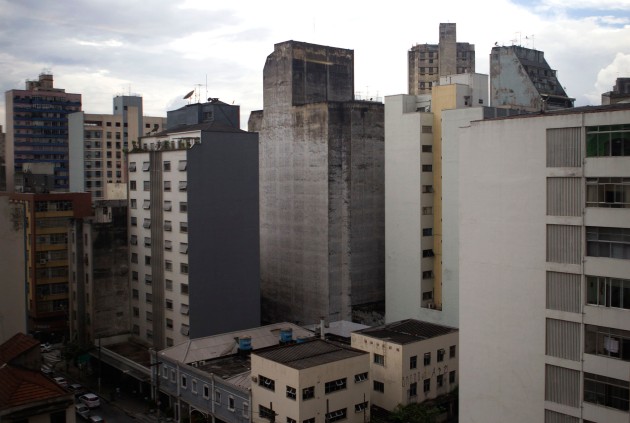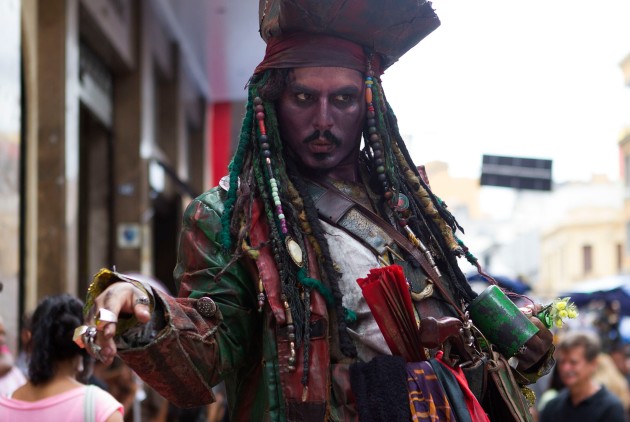Exploring an artistic community
December 19, 2012 2 Comments
It was an interesting day to say the least. My morning and afternoon were occupied with street vendors, performers, artists and of course, photographers.
I first took the subway to 25 de Março, an open market that was packed full of people. Street vendors sold items such as clothing and swimsuits, jewelry, purses, toys and everything in between. Live entertainment was also abundant.
While vendors and performers were lively and hard working, one person really caught my attention. A street artist by the name of Barto Rodrigues dos Santos painted tiles, which he then sold to passerby for 10 real (five U.S. dollars). Barto said he usually sells about 20 tiles per day, and even more on Saturdays.
Selling art every day is not possible for dos Santos because of the weather and unfair police discrimination. Supposedly, street art vending is legal in 25 de Março, but like many illegal vendors in the market, dos Santos said he’s been told to leave before.
When he’s not selling art, dos Santos works in a supermarket and does odd jobs. But even with this extra income, he’s barely getting by. He lives alone and does his best to support his six-year-old daughter, Victoria, who lives with her mother. Oftentimes however, dos Santos mother must loan him money to help support Victoria.
With 15 years of experience under his belt, dos Santos has become quite comfortable with his trade. He learned to paint like this while spending time in a bohemian area of Minas Gerais.
Although he enjoys painting in 25 de Março, dos Santos doesn’t want to stay here forever. He’s hoping to join an NGO in the future, where he can teach art to both children and adults. Until then, dos Santos plans to continue his artwork near and far. He enjoys discovering new places and uniting the “useful and the pleasant.”
—
Later in the day, Bruce, Bethany, Andrew and I visited Projecto Trecho 2.8, a photography organization in downtown São Paulo. Grácia, a project coordinator, described it as a program for people in a situation of high social vulnerability, or in other words, homeless. But Grácia shied away from using this term, simply because their situations can change. She explained that it’s not fair to label these people as homeless, as they’re still contributing members of society.
“Even though their living in these places, they don’t lose the human ability to create,” said our translator Guilia Afuine, after photography student Sandra de Olivera described the living situation of a friend. This particular person was paying 500 real (equivalent to 250 U.S. dollars) per month for a 2′ x 2′ apartment infested with rats. With such high rent for such low-scale housing, it’s no wonder Sao Paulo hosts a significant homeless population.
But as Guilia explained, these people’s situations have little effect on their creativity and imagination. Participants are provided cameras and taught basic photography techniques, before shooting images on their own. Gerson Roberto described the project as an anchor, a way to balance the positive and discouraging aspects of his life.

Valter Machado (left) and Alassandro Daniel Martins, both Projecto Trecho 2.8 participants, show and explain their photographs Wednesday.
Up until July, Projecto Trecho 2.8 was funded by young businesspeople. But now, participants are selling postcards, magnets and other items to make their project self-sustainable. To browse photographs and support Projecto Trecho 2.8, check out their website.
Overall, it was amazing to see such passion for photography coming from people who aren’t often given such opportunities. Sometimes raw talent and enthusiasm is overlooked because of outward appearances, but this wasn’t one of those times.

Projecto Trecho 2.8 participants and directors pose with UNL students, professor Bruce Thorson and translator Giulia Afuine.

Projecto Trecho 2.8 participant Tula Pilon (right) autographs a photo, using professor Bruce Thorson’s back as a tabletop.
Many thanks to Giovana Schlüter Nunes and Giulia Afuine for translation help today.
Until next time,
Cara Wilwerding.




